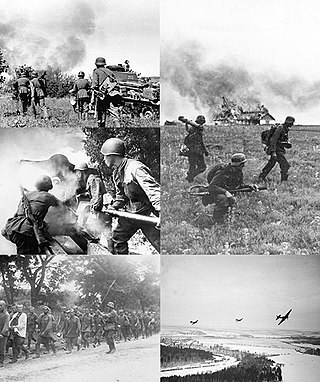
Operation Barbarossa was the invasion of the Soviet Union by Nazi Germany and many of its Axis allies, starting on Sunday, 22 June 1941, during World War II. It was the largest and costliest land offensive in human history, with around 10 million combatants taking part, and over 8 million casualties by the end of the operation.

Red Storm Rising is a war novel, written by Tom Clancy and Larry Bond, and released on August 7, 1986. Set in the mid-1980s, it features a Third World War between the North Atlantic Treaty Organization and Warsaw Pact forces, and is notable for depicting the conflict as being fought exclusively with conventional weapons, rather than escalating to the use of weapons of mass destruction or nuclear warfare. It is one of two Clancy novels, along with SSN (1996), that are not set in the Ryanverse.
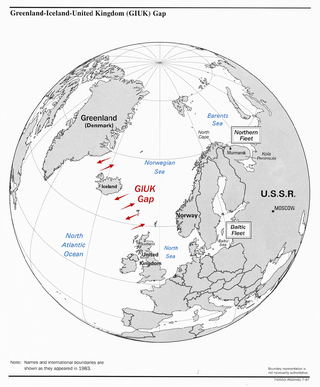
The GIUK gap is an area in the northern Atlantic Ocean that forms a naval choke point. Its name is an acronym for Greenland, Iceland, and the United Kingdom, the gap being the two stretches of open ocean among these three landmasses. It separates the Norwegian Sea and the North Sea from the open Atlantic Ocean. The term is typically used in relation to military topics. The area has for some nations been considered strategically important since the beginning of the 20th century.

The Fulda Gap, an area between the Hesse-Thuringian border, the former Inner German border, and Frankfurt am Main, contains two corridors of lowlands through which tanks might have driven in a surprise attack by the Soviets and their Warsaw Pact allies to gain crossing(s) of the Rhine River. Named for the town of Fulda, the Fulda Gap became seen as strategically important during the Cold War of 1947–1991. The Fulda Gap roughly corresponds to the route along which Napoleon chose to withdraw his armies after defeat at the Battle of Leipzig. Napoleon succeeded in defeating a Bavarian-Austrian army under Wrede in the Battle of Hanau not far from Frankfurt. From there he escaped back to France.

Günther Adolf Ferdinand von Kluge was a German Generalfeldmarschall during World War II who held commands on both the Eastern and Western Fronts. He commanded the 4th Army of the Wehrmacht during the invasion of Poland in 1939 and the Battle of France in 1940, earning a promotion to Generalfeldmarschall. Kluge went on to command the 4th Army in Operation Barbarossa and the Battle for Moscow in 1941.
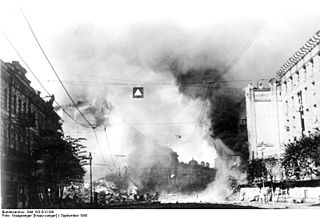
The First Battle of Kiev was the German name for the major battle that resulted in an encirclement of Soviet troops in the vicinity of Kiev during World War II, the capital and most populous city of the Ukrainian Soviet Socialist Republic. This encirclement is the largest encirclement in the history of warfare by number of troops. The battle occurred from 7 July to 26 September 1941 as part of Operation Barbarossa, the Axis invasion of the Soviet Union.
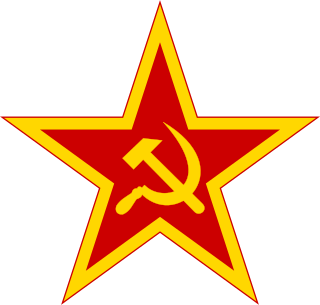
The Soviet Armed Forces, also known as the Armed Forces of the Soviet Union, the Red Army (1918–1946) and the Soviet Army (1946–1991), were the armed forces of the Russian SFSR (1917–1922) and the Soviet Union (1922–1991) from their beginnings in the Russian Civil War of 1917–1923 to the collapse of the USSR in 1991. In May 1992, Russian President Boris Yeltsin issued decrees forming the Russian Armed Forces, which subsumed much of the Soviet Armed Forces. Multiple sections of the former Soviet Armed Forces in the other, smaller Soviet republics gradually came under those republics' control.

Seven Days to the River Rhine was a top-secret military simulation exercise developed at least since 1964 by the Warsaw Pact. It depicted the Soviet Bloc's vision of a seven-day nuclear war between NATO and Warsaw Pact forces.

World War III is a 1998 German alternate history television pseudo-documentary, directed by Robert Stone and distributed by ZDF. An English version was also made, which aired on TLC in May 1999. It depicts what might have transpired if, following the overthrow of Mikhail Gorbachev, Soviet troops, under orders from a new hard-line regime, had opened fire on demonstrators in Berlin in the fall of 1989 and precipitated World War III. The film mixes real footage of world leaders and archive footage of combat exercises and news events, with newly shot footage of citizens, soldiers, and political staff.

The 44th Infantry Division was formed on 1 April 1938 in Vienna, about two weeks after the Anschluss of Austria. It first saw combat at the start of the war in the Invasion of Poland, and also took part in the Battle of France in 1940. After a 9-month period of coastal defence the division was transferred East. On 22 June 1941, the division took part in the invasion of the Soviet Union, attached to Army Group South. It remained in the east after the failure of "Operation Barbarossa", taking part in defensive actions for the winter against the Soviet Army offensives near Izum and Kharkov. Refurbished, the division participated in the German summer offensive, and was subsequently destroyed with the 6th Army at Stalingrad in January 1943.

The Western Allied invasion of Germany was coordinated by the Western Allies during the final months of hostilities in the European theatre of World War II. In preparation for the Allied invasion of Germany east of the Rhine, a series of offensive operations were designed to seize and capture its east and west banks: Operation Veritable and Operation Grenade in February 1945, and Operation Lumberjack and Operation Undertone in March 1945; these are considered separate from the main invasion operation. The Allied invasion of Germany east of the Rhine started with the Western Allies crossing the river on 22 March 1945 before fanning out and overrunning all of western Germany from the Baltic in the north to the Alpine passes in the south, where they linked up with troops of the U.S. Fifth Army in Italy. Combined with the capture of Berchtesgaden, any hope of Nazi leadership continuing to wage war from a so-called "national redoubt" or escape through the Alps was crushed, shortly followed by unconditional German surrender on 8 May 1945. This is known as the Central Europe Campaign in United States military histories.
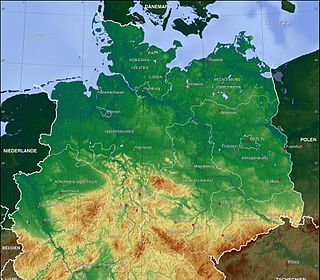
The North German Plain or Northern Lowland is one of the major geographical regions of Germany. It is the German part of the North European Plain. The region is bounded by the coasts of the North Sea and the Baltic Sea to the north, Germany's Central Uplands to the south, by the Netherlands to the west and Poland to the east.

The 39th Guards Motor Rifle Division of the Soviet Ground Forces was a mechanised infantry division active from 1965 to 1992. It was originally formed as the 39th Guards Rifle Division of the Workers' and Peasants' Red Army. It was formed during the German-Soviet War as part of the 62nd Army and assigned to the defense of Stalingrad, officially arriving at the theater in August 1942. In September the division fought through German forces which were attempting to encircle the city, and was assigned to defend the 'Volga Corridor,' the last supply line remaining for Soviet units in the city.

The first Jassy–Kishinev offensive, named after the two major cities Iași (Jassy) and Chișinău (Kishinev) in the area, was a series of military engagements between 8 April and 6 June 1944 by the Soviets and Axis powers of World War II. Richard C. Hall also refers to a first Jassy–Kishinev operation which began on 5 April, without providing an exact date for its end. According to Glantz, the purported offensive was a coordinated invasion of Romania conducted by Red Army's 2nd and 3rd Ukrainian Fronts, in accordance with Joseph Stalin's strategy of projecting Soviet military power and political influence into the Balkans.

The Northern Army Group (NORTHAG) was a NATO military formation comprising four Western European Army Corps, during the Cold War as part of NATO's forward defence in western Germany.
Defence in depth is a military strategy that seeks to delay rather than prevent the advance of an attacker, buying time and causing additional casualties by yielding space. Rather than defeating an attacker with a single, strong defensive line, defence in depth relies on the tendency of an attack to lose momentum over time or as it covers a larger area. A defender can thus yield lightly defended territory in an effort to stress an attacker's logistics or spread out a numerically superior attacking force. Once an attacker has lost momentum or is forced to spread out to pacify a large area, defensive counter-attacks can be mounted on the attacker's weak points, with the goal being to cause attrition or drive the attacker back to its original starting position.

The 108th Nevelskaya Motor Rifle Division, abbreviated as the "108th MRD," was a unit of the Soviet Ground Forces and the Armed Forces of Uzbekistan. It was the successor to the 360th Rifle Division. The division was created in August 1941 by the State Defense Committee and the Volga Military District Commander, Vasily Gerasimenko, in the Volga Military District. The 360th compiled a distinguished record of service during the Great Patriotic War on the northern sector of the Soviet-German front, including the award of a battle honor and the Order of the Red Banner.

Fifth Corps, subtitled "The Soviet Breakthrough at Fulda", is a board wargame published by Simulations Publications, Inc. (SPI) in 1980 that simulates a hypothetical invasion of West Germany by Warsaw Pact forces. The game is the first in the Central Front series of games.
The 417th Rifle Division was formed as an infantry division of the Red Army in the spring of 1942 and served in that role until after the end of the Great Patriotic War. Although it was formed in the Transcaucasus, unlike the 414th and 416th Rifle Divisions formed in about the same place at the same time it was never designated as a National division. After its formation it remained in service in the Caucasus under direct command of the Transcaucasus Front until the summer of 1942, when it was redeployed first to the Northern Group of Forces in that Front and then to the 9th Army. As German Army Group A retreated from the Caucasus in January, 1943 the division was reassigned to the 58th Army and a few months later to 37th Army in North Caucasus Front. In July it redeployed northward to join Southern Front, where it was assigned to the 63rd Rifle Corps in 44th Army in mid-September as the Front fought through south Ukraine, eventually reaching the land routes to the Crimea. It took part in the offensive that liberated that region in April and May, 1944, fighting in the 51st Army and winning both a battle honor and the Order of the Red Banner in the process. After the Crimea was cleared the 51st Army was moved far to the north, joining 1st Baltic Front. During operations in the Baltic states the 417th was further distinguished with the award of the Order of Suvorov. In March, 1945 it joined the Courland Group of Forces on the Baltic coast containing the German forces encircled in northwest Latvia. It ended the war there and was soon moved to the Ural Military District before being downsized to a rifle brigade. This brigade was briefly brought back to divisional strength during the Cold War.
The 119th Guards Rifle Division was formed as an elite infantry division of the Red Army in September 1943, based on the 11th Guards Naval Rifle Brigade and the 15th Guards Naval Rifle Brigade and was one of a small series of Guards divisions formed on a similar basis. Although the two brigades had distinguished themselves in the fighting south of Stalingrad as part of 64th Army they were moved to Northwestern Front in the spring of 1943 before being reorganized. After serving briefly in 22nd Army the division was moved to reinforce the 3rd Shock Army within the large salient that Army had created behind German lines after a breakthrough at Nevel in October. In the following months it fought both to expand the salient and defend it against German counterattacks in a highly complex situation. In January 1944 it was transferred to the 7th Guards Rifle Corps of 10th Guards Army, still in the Nevel region, after which it advanced toward the Panther Line south of Lake Peipus. During operations in the Baltic states that summer and autumn the 119th Guards was awarded both a battle honor and the Order of the Red Banner for its operations in Latvia. In March 1945 it joined the Kurland Group of Forces of Leningrad Front on the Baltic coast containing the German forces encircled in northwest Latvia. Following the German surrender it was moved to Estonia where it was disbanded in 1946.

















